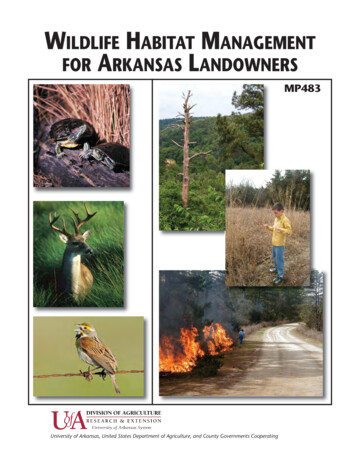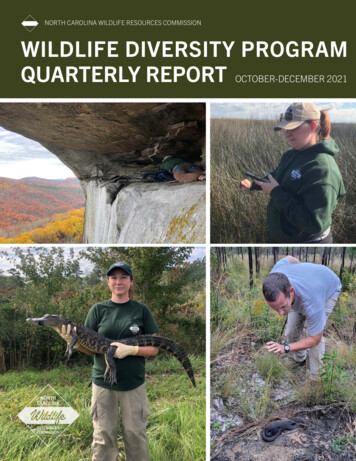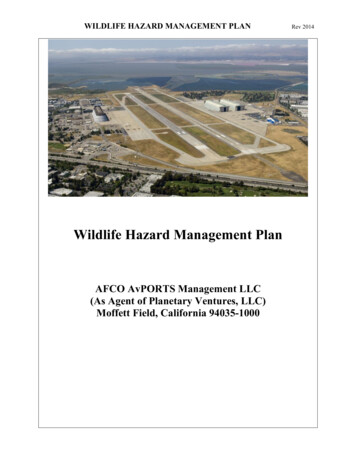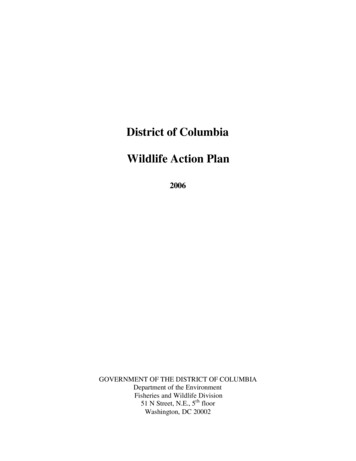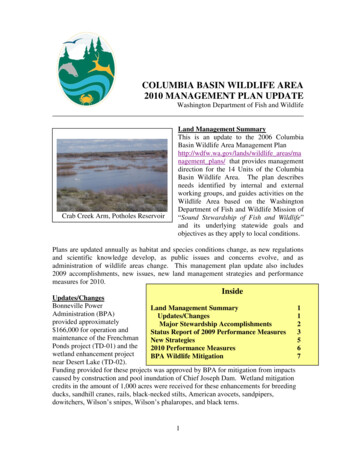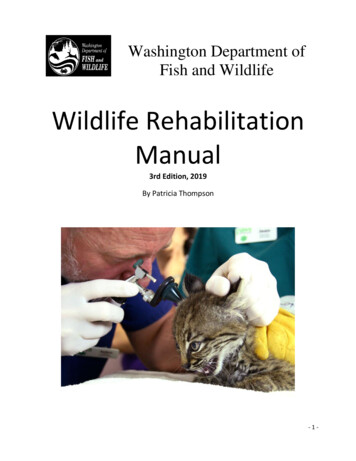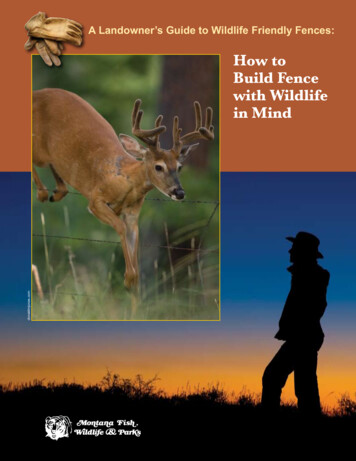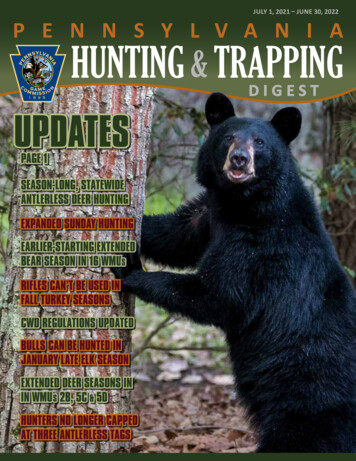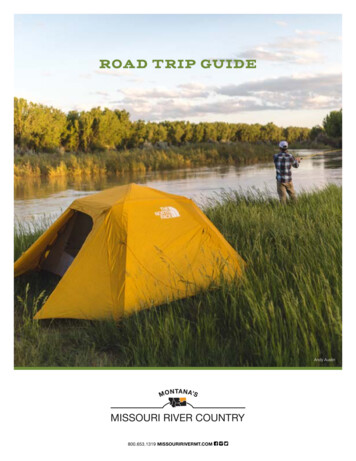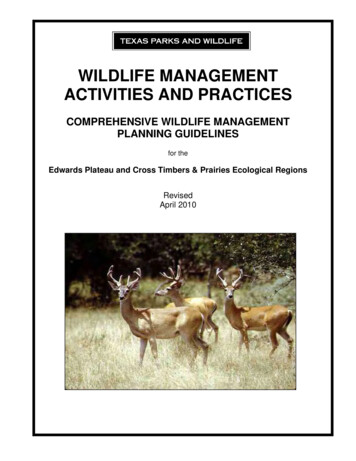
Transcription
WILDLIFE MANAGEMENTACTIVITIES AND PRACTICESCOMPREHENSIVE WILDLIFE MANAGEMENTPLANNING GUIDELINESfor theEdwards Plateau and Cross Timbers & Prairies Ecological RegionsRevisedApril 2010
The following Texas Parks & Wildlife Departmentstaff have contributed to this document:Mike Krueger, Technical Guidance Biologist – LampasasMike Reagan, Technical Guidance Biologist -- WimberleyJim Dillard, Technical Guidance Biologist -- Mineral Wells (Retired)Kirby Brown, Private Lands and Habitat Program Director (Retired)Linda Campbell, Program Director, Private Lands & Public Hunting Program--AustinLinda McMurry, Private Lands and Public Hunting Program Assistant -- AustinWith Additional Contributions From:Kevin Schwausch, Private Lands Biologist -- BurnetTerry Turney, Rare Species Biologist--San MarcosTrey Carpenter, Manager, Granger Wildlife Management AreaDale Prochaska, Private Lands Biologist – Kerr Wildlife Management AreaNathan Rains, Private Lands Biologist – Cleburne
TABLE OF CONTENTSComprehensive Wildlife Management Planning GuidelinesEdwards Plateau and Cross Timbers & Prairies Ecological RegionsIntroductionSpecific Habitat Management PracticesHABITAT CONTROLEROSION CONTROLPREDATOR CONTROLPROVIDING SUPPLEMENTAL WATERPROVIDING SUPPLEMENTAL FOODPROVIDING SUPPLEMENTAL SHELTERCENSUSAPPENDICESAPPENDIX A:General Habitat Management Considerations, Recommendations, and IntensityLevelsAPPENDIX B: Determining Qualification for Wildlife Management UseAPPENDIX C: Wildlife Management Plan OverviewAPPENDIX D: Livestock Management RecommendationsAPPENDIX E: Vegetation Management RecommendationsAPPENDIX F: Specific Management Recommendations for White-tailed DeerAPPENDIX G: Specific Management Recommendations for Bobwhite QuailAPPENDIX H: Specific Management Recommendations for Wild TurkeysAPPENDIX I:Comments Concerning Federally Listed Endangered and Threatened SpeciesAPPENDIX J: Nongame Wildlife Management RecommendationsAPPENDIX K: Guidelines for Native Grassland Restoration ProjectsAPPENDIX L: Conducting White-Tailed Deer Spotlight Surveys in Central TexasAPPENDIX M: Herd Composition: An Essential Element of White-Tailed Deer Populationand Harvest Management in Central TexasAPPENDIX N: Food Plots for White-tailed Deer in Central TexasAPPENDIX O: Wildlife Watering FacilitiesAPPENDIX P: Managing Red Imported Fire Ants in Wildlife AreasAPPENDIX Q: Trapping Brown-headed Cowbirds to Control Songbird Nest ParasitismAPPENDIX R: Small Acreage Management Techniques (AbridgedAPPENDIX S: The Value of Dead and Down WoodAPPENDIX T: Sunflowers for Wildlife in the Cross TimbersAPPENDIX U: FormsAPPENDIX V: ReferencesAPPENDIX W: Shared Wildlife ResourcesAPPENDIX X: Wildscapes Native Plant List and BibliographyAPPENDIX Y: Learn About WhitetailsAPPENDIX Z: Pesticides and Brush ControlAPPENDIX AA: Requirements for Supplemental Shelter - Edwards Plateau, Crosstimbers
COMPREHENSIVE WILDLIFE MANAGEMENT PLANNING GUIDELINESfor theEdwards Plateau Ecological Regionand theCross Timbers and Prairies Ecological Region(Prepared in partial fulfillment of the requirements of HB 1358 - Wildlife ManagementProperty Tax Valuation and HB3123 - relating to the standards for determining whetherland qualifies for appraisal for ad valorem tax purposes as open-space land based on itsuse for wildlife management.)IntroductionThe Texas Constitution and the legislature provides those landowners with a current 1d-1 Agricultural Valuation (often known as an Ag Exemption) an opportunity to changefrom a traditional qualifying agricultural practice to wildlife management as a qualifyingagricultural practice while maintaining the current valuation.HB 1358 byRepresentative Clyde Alexander provided that the landowner must implement andcomplete at least one management practice from at least three of the seven wildlifemanagement activities listed in Appendix A. Most landowners interested in wildlife canmeet this requirement and implement several practices beyond the minimum required.The 2001 legislative session passed HB3123, co-sponsored by Representative BobTurner and Representative Clyde Alexander. This bill provided for further clarification ofthe standards required for determining whether land qualifies for appraisal as openspace land based on wildlife management. As a result of HB3123, more uniformstandards of qualifying for wildlife management have been applied statewide.Wildlife Management Tax ValuationLand that qualifies for an agricultural valuation is appraised on its productivity valuerather than on its market value. While many people refer to such land as having an “agexemption”, in fact there is no such exemption—it is just a different method ofcalculating the land’s value for ad valorem tax purposes. Correctly speaking, such landhas an agricultural valuation.Under Texas law, wildlife management is legally nothing more than an additionalqualifying agricultural practice people may choose from in order to maintain theagricultural valuation on their land. Just as there is no real ag “exemption”, there also isno wildlife “exemption”. Wildlife management is not an additional appraisal, nor is itseparate from “traditional” agriculture.For ad valorem tax purposes wildlifemanagement is agriculture. There is no change in the ad valorem tax valuation withwildlife management, only a change in the qualifying agricultural practice.Acreage RequirementsThere are no minimum acreage requirements unless since the previous tax year thelandowner has sold, gifted, or otherwise reduced the size of their ag appraised property;the landowner has purchased or otherwise acquired property that has been partitioned
out of a larger agriculturally qualified tract. When either a change in ownership or tractsize occurs, the minimum acreage requirements apply.Landowners acquiring property that has been partitioned out of a larger qualifying tractsince the previous tax year, and those who have reduced the size of their property needto be certain that the property will meet the minimum size as set by the county. Refer toAppendix B for the maximum and minimum acreages by region, and to your countyCentral Appraisal District office for the minimum acreage size adopted. It is importantto note that regardless of the property size, it must still be appraised for open-space usebefore it is eligible to change over to wildlife management use.When a qualifying tract of land is broken into smaller tracts and sold, the standards forminimum eligible tract size take effect. These sizes are determined by location withinthe state. Within each area, the county has the ability to choose within a specifiedrange the minimum qualifying acreage. Tracts below this minimum size are not eligibleto manage for wildlife as their agricultural practice for ad valorem tax purposes. Theexception is for landowners who are buying property in a Wildlife Management PropertyOwners’ Association.Wildlife management property owners associations arecommunity developments similar to wildlife management co-ops, but differ in that eachperson buying into the neighborhood must make a legal commitment to practice acertain level of wildlife management. Deed restrictions, conservation easements,property owner agreements, or other legally binding covenants insure that the habitatfor wildlife is protected and managed in exchange for landowners being able to maintainan agricultural valuation based on wildlife management. If such legally bindingcovenants exist, the county may set a 1% or 2% lower minimum acreage requirement.These same lower minimum acreages also apply to landowners who have habitat forthreatened or endangered species or a species of concern. While the actual presenceof the species on the property is not required, a qualified wildlife professional must verifythat the habitat for the species does in fact exist on theproperty before this exception is granted by the county.Although landowners with smaller tracts of land areencouraged to work cooperatively with their neighbors forsome wildlife management practices, such as conducting apopulation census, each landowner must also individuallybe doing three practices of an appropriate intensity level ontheir property, submit their own individual wildlifemanagement plan and be able to qualify on their own.The Wildlife Management PlanThis guide is intended to provide landowners with information to develop their ownplans. The plan may be as simple or as extensive as the landowner chooses. Thepractices described in this guide are intended only as guidelines. Certain site-specificsituations may necessitate changes that can be allowed if based on trained resourceprofessionals’ recommendations.
All landowners are required to develop and submit a wildlife management plan to thecounty Central Appraisal District along with their 1-d-1 Open Space AppraisalApplication. All wildlife management plans must be on the form provided by TexasParks & Wildlife Department. This form, PWD 885-W7000, is included in Appendix U.While a comprehensive and highly detailed written wildlife management plan asdescribed in these guidelines is not required by the county, it is highly recommendedthat the landowner go through this lengthier exercise and use this lengthier plan as aguide when filling out the required PWD 885-W7000 wildlife management plan form.The plan must address a separate practice in at least three of the seven wildlifemanagement categories.A wildlife management plan describes historic and current land use practices,establishes landowner goals and objectives (also family goals if desired) for theproperty, and describes specific activities and practices designed to benefit wildlifespecies of interest and their habitats. This is the landowner's plan, designed by thelandowner with the possible assistance of a wildlife biologist of the Texas Parks andWildlife Department [TPWD], Texas AgriLife Extension Service [TAE], USDA NaturalResource Conservation Service [NRCS, formerly Soil Conservation Service - SCS],Texas Forest Service [TFS], or other qualified wildlife biologist. Efforts to performactivities identified in the plan are completely voluntary on the part of the landowner,except those practices that are necessary to maintain the agricultural appraisal forwildlife management use.A complete plan will likely include elements of all seven listed wildlife managementactivity categories. While Texas Parks and Wildlife Department biologists are availableto assist landowners in developing a wildlife management plan for ad valorem taxpurposes, it should be noted that the Department’s participation is not required in orderfor the wildlife management plan to be valid.What Paperwork to FileAll paperwork for changing the land’squalifying agricultural practice over to wildlifemanagement must be filed with the ChiefAppraiser at the county’s Central AppraisalDistrict. No paperwork is required to be filedwith Texas Parks and Wildlife Department.Landowners will need to complete a 1-d-1Open Space Appraisal Application availablefrom their Central Appraisal District and attachto it the completed PWD 885-W7000 wildlifemanagement plan that is included inAppendix U.With 95% of Texas privately owned, the wildlife thatbelongs to the people of Texas depends on privatelandowners to voluntarily provide them with qualityhabitat.
Habitat ControlGrazing ManagementPrescribed BurningRange EnhancementBrush ManagementRiparian Management and EnhancementWetland EnhancementHabitat Protection for Species of ConcernPrescribed Control of Native, Exotic, and Feral SpeciesWildlife Restoration
HABITAT CONTROL (HABITAT MANAGEMENT)IntroductionHabitat is defined as the physical and biological surroundings of an organism andprovides everything that a living organism needs to survive and reproduce. The threebasic requirements of any wildlife species to survive and reproduce are food, water, andshelter. Quite frequently, we as land managers tend to focus on a specific wildlifespecies and its needs as opposed to the habitat or community in which they live. Thekey to managing wildlife and our natural resources is to use a holistic approach andpromote healthy ecosystems. Single species deserve less attention, while the system inwhich they thrive requires more. Knowing how a system functions and applying thetechniques with which that system developed is imperative for its continued health andexistence.Ecosystems are dynamic and continuously changing. Succession is the change in plantspecies composition and structure over time. It is succession that we as land managersare trying to manipulate. Generally the earlier the successional stage the greater theplant diversity and the greater the number of wildlife species that are benefited. This isnot to say that some species are not dependant on later successional stages or evenseveral stages. Managing for a diversity is important. Maintaining a variety of habitattypes--while at the same time promoting plant diversity in both species composition andstructure within each habitat type, should be the goal of all good wildlife managementprograms.Aldo Leopold, who is known as the “Father of Modern Wildlife Management”, authored abook in 1933 titled Game Management. In this textbook Leopold wrote ".game can berestored by the creative use of the same tools which have heretofore destroyed it - ax,plow, cow, fire, and gun". Habitat control or habitat management, as it is most oftenreferred, is the active application of these “tools” to the land in order to promote landhealth and enhanced availability of the 3 basic requirements to all wildlife species. It isvery important that land managers today understand basic ecological principles of plantsuccession; plant growth; food chains; and water, mineral and soil nutritive cycles asthey affect range, wildlife, and grazing management. This not only produces highquality habitat and animals, but alsocan lead to more stable conditionsduring stress periods such asdroughts and winter.Grazing ManagementPeople often view grazing livestockasbeingincompatiblewithmanaging for wildlife. Although thiscan be the case, when properlyutilized grazing can be beneficial towildlife habitat. Focusing on goodland management as opposed tostrictly livestock production allows a
landowner to adjust the presence or absence of livestock as well as a grazing time andintensity level that is beneficial for both plant health and diversity.Grasses evolved with grazing pressure. Historically great herds of bison roamed thecentral part of the United States and stayed constantly on the move in search of newforage and in front of predators. Bison came into an area, grazed it down, and left.Herds were never in any given area for an extended length of time. Sheer numbers ofbison in the herd did not allow the animals to be selective about plants that were bitten;animals were forced to eat every palatable plant in an area. This type of grazing didseveral things to sustain a diverse mid- and tall-grass plant community. The intensepressure left a lot of tilled and well fertilized soil. It also decreased the overall quantity ofgrass and allowed sunlight to reach the lower growing forbs (weeds & wildflowers).Grasses with deeper root systems responded quicker during the absence of bison thanthose with shallower root systems. While intense for a short time period, this type ofgrazing provided long rest periods of the range and allowed rapid responses of annualforbs and grasses. The final result was more plant diversity and more wildlife foods.Bison opened stands of dense grasses providing more food for deer, turkey, quail,prairie chicken, and songbirds. Without grazing pressure neither the grasses nor theforbs respond the same, consequently, the diversity as well as the health of the systemis diminished. Undoubtedly, bison were a major force that shaped the ecosystem.European man brought with him his own form of agriculture and the range appearedunlimited in its ability to support a great number and variety of livestock (cattle, sheep,goats, oxen, hogs, and horses). The demise of the bison and changes in land usepatterns eventually brought fences and livestock which were increasingly grazed inpastures with limited or no rest periods.Forage availability and production is dependant on stocking rates, rest, and rainfall.Sedentary grazing or limited rotation grazing with even average stocking rates andrainfall can create severely abused and overgrazed range. Grasses are continuallygrazed beginning with the most palatable first and on down the line until the plantcommunity consists primarily of less desirable shallow rooted grasses and a fewundesirable forbs. Overall plant diversity decreases. An abused range lacks adequategroundcover and available browse to support healthy livestock and wildlife populations.Overgrazing with domestic livestock causes problems in managing for healthyecosystems.Good grazing management starts with the basics: 1) the kind and class of livestockgrazed 2) stocking rate or intensity 3) duration of grazing to provide rest periods for thepastures and 4) excluding livestock from sensitive areas to promote vegetationprotection and/or recovery.In an ideal livestock grazing program, the goal should be high intensity - short duration.The stocking rate is such that every plant should be bitten off once during each grazedperiod or rotation. Sedentary grazing allows plants to be bitten over and over startingwith the most palatable first. The less desirable plants keep growing while the more
palatable ones continue to get bitten. This can result in a pasture being underutilizedbut still overgrazed and eventually the removal of the most desirable species. Havingenough animals to bite the plants only once means livestock can only stay in one placefor a short period of time before they have to be moved to another pasture. A highintensity - short duration grazing requires a number of pastures within the grazingsystem to allow for extended rest periods.High intensity - short duration grazing systems allow livestock to act as a tool tomanipulate and enhance wildlife habitat and plant diversity as the bison did historicallyin our grassland and savannah ecosystems. There are a number of variations of thissystem; finding one that you are able to implement on your property is the key. If it isunrealistic to divide a property into enough small pastures to both sufficiently graze andrest the range, a small landowner may want to contact neighbors to pool property andallow each property to serve as a pasture in a grazing rotation. Properties without theseoptions may have to use prescribed burning and/or mowing to achieve some of theresults and benefits of grazing.For additional information see Appendix D. Contact the Texas Parks and WildlifeDepartment’s Kerr Wildlife Management Area at 830-238-4483 or write to Kerr WMA,2625 FM 1340, Hunt, TX 78024 to schedule a visit and see the effects of both grazingsystems and “over-rest” situations.Prescribed BurningBison were not the only major force shaping the ecosystem in which pronghornantelope, black bear, wolf, white-tailed deer, turkey, quail, and prairie chicken alsothrived historically. Fires, natural and man-made, played an integral role in perpetuatingthat system. Fire is a natural ecological factor to which native vegetation is welladapted. Since the 1850s, because man has suppressed fire, the grasslands andsavannahs that were once dotted with occasional mottes of trees and forests or alongdrainage systems are now dominated by brush and woodlands. Europeans suppressedfire to prevent damage to wooden structures, farmlands, fences, and grazing lands. Inturn this eliminated or reduced the role that fire played in maintaining ecosystems thatwere dominated by herbaceousvegetation.Prescribed burning is theplanned application of fire to setback plant succession.Itimproves habitat and plantdiversity and returns nutrients tothe soil. Burning can improveaccessibility, increase bothquantity and quality of forageandbrowseproduction,suppress brush and cactus,improve grazing distribution of
livestock and wildlife, and remove excessive thatch and debris. Prescribed burning is atool used to maintain desired vegetation composition and structure.Achieving a management objective requires a particular set of conditions for burningand a specific type of fire or burn prescription. A burn prescription defines the range ofconditions and factors under which a fire boss will light a fire to meet these specificobjectives. Factors that influence the type of fire and its intensity include time of theyear, fuel quantity and moisture, air temperature, humidity, soil moisture, wind speed,geographic area, and direction of the flame front movement in relation to the wind.Generally summer fires are hotter type fires and winter-spring fires are cooler burningfires. As fuel quantity goes up and fuel moisture goes down, the the intensity of a fireincreases. The same goes for higher the wind speed and air temperature: the lower thehumidity and soil moisture, the hotter the fire. Fire set to move in the same direction asthe wind is a called a headfire, whereas fire set to move against the wind is a backfire.Headfires burn hotter than backfires.The plant response after a fire is influenced by fire intensity, plant condition at the timeof the burn as well as weather conditions and grazing management practices followingthe burn. For example, forbs are prolific seed producers and valuable resource forwhite-tailed deer and other wildlife species. Forb seedlings are highly susceptible tofire, and a late winter burn after annuals have germinated may reduce forb productionfor the following growing season. A winter burn used to target certain evergreen treesor shrubs, such as Ashe juniper (cedar) or yaupon holly, is less likely to harm deciduoustrees such as oaks than a late summer fire used to target the same species. Burnedpastures can be grazed immediately to reduce grasses that compete with forbs or tomake use of now palatable prickly pear and then deferred to allow the pasture to rest.White-tailed deer and exotic wildlife numbers may have to be reduced prior to burning toallow time for preferred plants to reestablish following the burn.A successful prescribed burn includes 3 basic steps: 1) develop a burn plan whichshould include management goals and objectives, burn prescription, safety plan,description and map of the burn unit, smoke management, legal requirements, contactsand notifications, control and firing plan, and evaluation 2) a safe and effectiveexecution of the burn on the planned site and 3) good range, livestock, and wildlifemanagement to maximize the effects of the burn. Inexperienced managers should askfor assistance and/or advice from agencies such as Texas Parks & Wildlife or theNatural Resources Conservation Service. While instructional materials are available, itis suggested that the novice assist on a burn conducted by an experienced personbefore attempting a prescribed burn. In some parts of the state, landowners havebanded together to form prescribed burning associations to share knowledge,equipment and assist each other in conducting controlled burning.For additional information contact the Texas Parks and Wildlife Department’s KerrWildlife Management Area at 830-238-4483 or write to: Kerr WMA, 2625 FM 1340,Hunt, TX 78024 to schedule a visit and see the effects of a good prescribed burnprogram.
Range EnhancementMismanagement and overgrazing can lead to abused rangeland. Continuous overutilization by livestock and/or white-tailed deer and exotics can remove certain desirableand highly palatable plants from a system. In many areas, plant communities nowconsist of lower stage succesional species of native annual and perennial cool seasongrass and forb or other non-native plants. Past land use practices such as mechanicalclearing or farming may cause some plants to become rare or even nonexistent oncertain ranges. Range enhancement is the re-establishment or enhancement of plantcommunities with native grasses and forbs. These plants provide both food and coverfor wildlife and help to meet the three basic requirements.Seeding mixes should provide for maximum native plant diversity and should includeseveral broadleaf native perennial plants which are important forage for wildlife andseed production. Range enhancement should include appropriate plants or seedmixtures as well as approved methods for planting in the particular ecological regionwhere the property is located. Non-native species are not recommended and should beused only in rare and very specific cases. Even then non-natives should not exceed25% of the seeding mix.Managing, restoring, and/or protecting native grass prairies is also considered rangeenhancement. This may or may not include actual reseeding but could include utilizingsome of the “tools” to manage for the earlier successional stages of a native prairie.Grazing, burning, and mechanical disturbance (mowing or plowing) are all options tomanage and restore native prairie.For additional information see Appendix E.Brush ManagementHistorically, bison and fire had a significant impact on plant communities, but with theremoval of these major influences plant communities have changed. Without fire and ahigh intensity - short duration type grazing regime, plant communities began to see anincrease in woody plant species and a change from grassland or savannahcommunities to more brushland or woodland habitat types. As brush continues toincrease and forms closed canopies, cutting off sunlight to the area underneath, grassand forb production as well as overall diversity decreases. Some woody species suchas Ashe juniper tend to increase at rates greater than others, and can begin to dominatea system. Ashe juniper has had a tremendous impact on the ecosystem by causing anincrease in soil erosion and significantly less water absorption. Cedar brakes lose asignificant amount of precipitation through transpiration and overland flow, leaving muchless water for aquifer recharge to insure adequate groundwater in the future.As mentioned before, a diversity in both plant composition and structure within differenthabitat types is the key to successful wildlife management. An area that is dominated byany single type or species of plant is rarely going to meet the needs of even a singlespecies of wildlife. Using the “tools” that Leopold described is the key to managing your
property and providing the adequate amount and arrangement of brush, trees, grassesand forbs to meet the needs of a wide variety of wildlife species.Although a good grazing management and prescribed burn program can reduce theneed for brush management, use of the “axe” may be necessary where other methodsare not practical or cost effective. A real axe is rarely used in the 21st century whendealing with extensive brush or woody encroachment. Today, chainsaws, herbicide andmechanical equipment such as bulldozers or tree shears take its place and are used tomanipulate problematic invasive woody vegetation.Brush management is only part of a good habitat management program and should beplanned carefully to address overall management goals. The primary principles thatdrive any good brush management program are: 1) extent 2) pattern 3) selection and 4)method. The extent to which brush is going to be cleared is the first step in developinga program. Overall goals of the property should be examined and can help to dictatethe amount of clearing needed to meet wildlife, livestock and/or aesthetic expectations.Clearing 100% of the brush may be best from a livestock production standpoint, but ifyour overall goal includes white-tailed deer management, you may only want to clear50% or less. Removal of only individual plants may be all you need to do depending onthe amount of brush you have. The pattern in which brush is cleared should considerwildlife cover and accessibility. This may include cover from predators, nesting cover,loafing cover or roosting cover. Maintaining travel corridors that link sections of brush isalso very important. Selection includes both the site and the species of brush to becleared. The site of brush clearing is important to make sure potential soil erosion iskept to a minimum. Soil type and slope should be considered. Certain soils may alsobe selected for clearing because of better forage production. Removal of desirableplant species used by wildlife for food and cover should be kept to a minimum. Themethod(s) used will be determined by a total cost analysis, soil erosion issues, and thetype or species of brush which is being targeted.For additional information contact the Texas Parks and Wildlife Department’s KerrWildlife Management Area at 830-238-4483 or write to Kerr WMA, 2625 FM 1340, Hunt,TX 78024 to schedule a visit and see the effects of brush management programs.Forest ManagementThe forests of Texas are as diverse as the landscape itself. Much of the historiclandscape was dominated by grasslands with occasional mottes or scattered groups oftrees interspersed. Aside from the pine forests of East Texas, forested areas weregenerally restricted to bottomlands along major rivers and creeks, or in areas protectedfrom fire. Settlers in East Texas discovered a vast forest comprised of a variety of bothpine and hardwood species. Pines, for the most part, dominated the uplands whilehardwoods dominated the bottomlands. Agricultural production, commercial timberproduction, and other changes in land management, including virtual elimination of fire,the forests of today are very different than those present during pre-settlement times.
Forest management may include establishing, maintaining, harvesting, selectivelyremoving or suppressing trees or woody species to allow for the growth of desirabletrees, shrubs, grasses, and forbs for forage and nesting or protective cover for a vari
All landowners are required to develop and submit a wildlife management plan to the county Central Appraisal District along with their 1-d-1 Open Space Appraisal Application. All wildlife management plans must be on the form provided by Texas Parks & Wildlife Department. This form, PWD 885-W7000, is included in Appendix U.
